Orthognathic Surgery(Surgical correction of facial deformities)
What is Orthognathic Surgery?
Ortho means straighten and gnathia means jaw, and hence, Orthognathic Surgery means surgical straighting of the jaw(s). This is a sub specialty of Oral and Maxillofacial Surgery. The surgeon envisages changing the face of a person from distortion to proportion. Orthognathic Surgery is sometimes called "Surgical Orthodontics" because just as an orthodontist repositions the teeth with the help of braces within the oral cavity, the Oral & Maxillofacial Surgeon repositions one or more jaws through surgical procedures to produce a much more pleasing appearance and function. The main objective of Orthognathic Surgery is the correction of a wide range of minor and major facial and skeletal (jaw) irregularities. The shape of the face depends on the architectural framework of the facial skeleton. Through Orthognathic Surgery the Surgeon could reposition the bones of the face and the jaw to a more aesthetically acceptable position.
Overview- Who needs orthognathic surgery?
- Pre surgical analysis
- Common surgical procedures
- Post surgical cares to be taken
- Complications of Orthognathic Surgery
Who Needs ?
Jaw growth is a gradual process in accordance with the growth of a person. In some instances the upper and lower jaw or one side of the jaw to the other may grow at different rates. This may cause many functional and aesthetic problems. Injuries to the jaws at a young age or birth defects may affect the normal growth of the jaws. While Orthodontic treatment (braces) can correct many problems if only the teeth are involved Orthognathic Surgery maybe required if the jaws (bone) also need correction.
The common maxillofacial deformities and their clinical appearances are the following:
1. Protruded Maxilla (upper jaw) and excessive growth
The upper jaw is protruded beyond the normal limits along with the teeth. The person cannot close the lips (lip incompetence) without effort. The teeth are often visible at rest and in most cases there is excessive visibility of the gum (gummy smile). A gummy smile is mainly due to the vertical excess of the maxilla.The common procedures done on the maxilla are Lefort 1 Osteotomy and anterior Maxillary Osteotomy
-
 Before
Before -
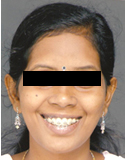 After
After -
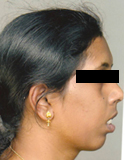 Before
Before -
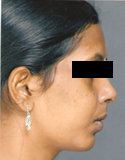 After
After
2. Retruded Maxilla
This deformity is due to under development of the upper jaw mainly seen in people who have cleft lip or palate. After the surgical correction of the cleft lip and palate at a young age the growth of the maxilla is retarded along with mal alignment of teeth. These results in a dish shaped face with a hooked or flaring nose and irregularly aligned, rotated or missing teeth.
-
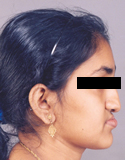 Before
Before -
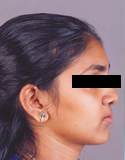 After
After
3. Protruded Mandible (lower jaw)
In some people there will be extra growth of the lower jaw resulting in long jaw. The face is very long with protrusion of the lower jaw with thick lips. Normally on biting the lower teeth will be inside the upper teeth while in people with long jaws often the lower teeth will be outside the upper arch. The common procedure done on the mandible are Sagittal Split Osteotomy done on the Ramus, Body Osteotomy, Genioplasty etc.
-
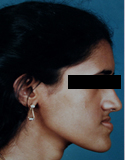 Before
Before 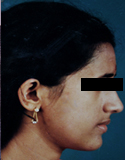 After
After
4. Retruded Mandible
In some people due to developmental deformity or due to hereditary factors the lower jaw is very small resulting in a "bird face". There is no proper development of the chin. Mandible and chin can be advanced by surgery.
-
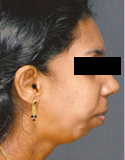 Before
Before -
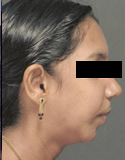 After
After
5. Facial Asymmetry
Sometimes a part of the face maybe overdeveloped or underdeveloped causing one part of the face to be small or large. One side of the face is not in symmetry with the other side giving an unaesthetic appearance. In most of the cases two jaw surgery is required to correct the asymmetry.
-
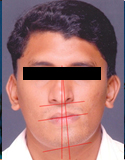 Before
Before -
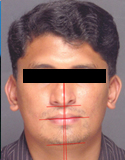 After
After
6. Ankylosis of Temporomandibular Joint (TMJ)
Injury during birth or trauma or infection at a young age to the Temporomandibular joint will result in restricted mouth opening and reduced growth of the mandible resulting in a bird face appearance. These deformities can be corrected by surgery on the joint and the person can open the mouth well an d the function is restored. The deformity of the face can also be corrected,
-
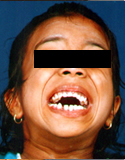 Before
Before -
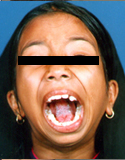 After
After
7. Nasal Deformity
Nasal deformities are often seen along with cleft lip and palate and independently also. Some common deformities of the nose are: deviated nasal septum, flared or constricted ala of the nose, saddle nose, hooked nose, asymmetrical nose, etc.
-
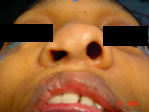 Before
Before -
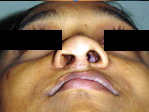 After
After
8. Esthetic Correction for Cleft Patients
The growth of the maxilla is adversely affected in cleft lip and palate patients, and they have malaligned teeth retarded growth of the maxilla crooked nose etc. These patients may require multiple surgeries
-
 Before
Before 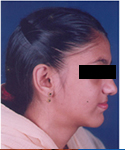 After
After
Pre Surgical Analysis
Evaluation:
A thorough examination with facial measurements, photographs, x-rays, and dental impressions are made. A complete medical examination is done to rule out any health problems that would interfere with the surgery or the administration of General Anesthesia.
Pre-surgical Orthodontia:
The Oral & Maxillofacial Surgeon and the Orthodontist will work closely together during the treatment. Orthodontic treatment is started before surgery. The teeth are moved and repositioned into proper alignment before surgery.
Preparing for the Surgery:
Orthognathic Surgery is done in a hospital under general anesthesia. Usually the person has to get admitted in the hospital one day prior to the surgery for investigations and preperations.
Surgical Procedures:
Orthognathic Surgery lasts anywhere from 2 hours to several hours depending on the amount and type of surgery needed. Surgery is done under general anesthesia. Incisions are often made inside the mouth and hence there will not be any visible external scars. However in certain cases external incisions may become necessary,if so, care is taken to conceal it in the natural skin creases or folds. Meticulous suturing technique can reduce the scar formation.
Common Surgical Procedures
1. Lefort I Osteotomy:
This is the surgical procedure done on the maxilla (upper jaw) to shorten or lengthen the maxilla to correct maxillary protrusion,vertical excess or retrution. The upper jaw is cut and repositioned to correct the deformity.
2.Anterior Maxillary Osteotomy:
This is used to correct the protrusion of the maxilla. This procedure is often combined with LeFort ! osteotomy or independently as per the requirement
3.Saggital Split Osteotomy:
This procedure is done on the mandible (lower jaw) to shorten or lengthen the mandible to correct long jaw or retruded jaw respectively. After putting an intraoral incision a split is made at the ramus of the mandible. The jaw is repositioned and the jawbones are held together with the help of screws and bone plates.
4.Genioplasty:
This is used to correct the defects of the chin. Chin can be moved in all the three dimensions by surgery. Chin can be augmented, reduced, moved to the sides etc.
5.Rhinoplasty:
This is used to correct the deformities of the nose. It can be done along with orthognathic surgery or separately.
What are the Post-Surgical cares to be taken?
Post operatively the patient is shifted to the recovery room and later to the Intensive care unit for about 24 hours. As the surgery is done inside the mouth, ther will be some difficulty in eating and moving the jaws. Patients may have to subsist on liquid and soft diet for some time. There will be some pain and discomfort for the patient.. Since orthognathic surgery is essentially a cosmetic procedure, post operative discomforts can occasionally depress the patient. Support from relatives and friends is very essential during these period Since the bone takes almost three months for healing excessive physical activity during this period is not advised. Swelling and some discomfort may be present for about two to three weeks which completely resolve by three minths only. The position of the teeth will change after surgery and there will be some difficulty in chewing. Post operative orthodontic treatment is meant for correcting and establishing good occlusion which essential for function. Post operative orthodontic treatment may last for about a year or more.
What are the Complications of Orthognathic Surgery?
Complications seen in any major surgery under general anesthesia may be seen in orthognathic surgery. Swelling, pain, nausea, vomiting, bleeding, infection, chest infections, etc are some of the potential risks of any major surgery under general anesthesia. Other complications specific to orthognathic surgery are
- Loss of sensation resulting in numbness or tingling sensation of the chin, cheek, nose or tongue may occur after surgery. Sensation returns to the affected areas as the nerve fibers regenerate and mend themselves, after a few months of surgery. Rarely some individuals may experience permanent altered sensation.
- Sinus complications such as sinusitis may occur after surgeries of the maxilla. This may not require any further treatment as it usually corrects it selves after a period of time.
- Nonvitality of teeth near the osteotomy site is seen rarely. This may require root canal treatment of the involved tooth at a later date.
- Relapse or unpredicted shifting of the new jaw position occurs uncommonly. If it does then further surgical intervention would be necessary.
- Periodontal infections around the teeth near the osteotomy site may cause mobility of the concerned teeth. This may be corrected by periodontal flap surgery and bone grafting.
- Necrosis of bone is seen rarely. This could be due to reduced blood supply to the area and will require surgical removal of the infected bone and related tooth/teeth
- Major complications like loss of osteotomised segment of the jaw, due to necrosis, blindness, major infections, uncontrolled bleeding, though reported in literature are uncommon. Most of these are inadvertent and unexpected complications.
- Unrealistic expectations by the individual will result in dissatisfaction of the "new" face. Some imagine and attribute all their psychological problems to their facial deformity and will not be satisfied even if good results are achieved. Individual satisfaction is very subjective and a positive attitude from the parents, relatives and friends are important.
